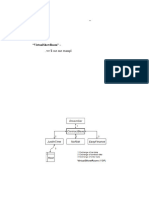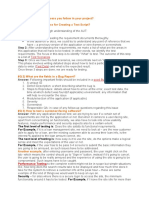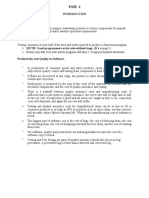0 ratings0% found this document useful (0 votes)
44 viewsTesting Done Right
Testing Done Right
Uploaded by
eduardoDiaz98The document discusses software testing and the inherent risks of introducing defects through changes. It describes the different types of testing (integration, functional, acceptance, quality, staging) and explains that while thorough testing can reduce risks, it cannot eliminate them completely. Testing aims to answer questions about functionality, requirements, and quality to a "good enough" level rather than 100% certainty. The risk of changes depends on the change impact, potential severity of defects, and thoroughness of testing. The weakest link is where defects are most likely to slip through. While comprehensive unit testing is good, other types of testing must not be inadequate. Defects are not necessarily problems, and it sometimes makes sense to prioritize features over exhaustive testing
Copyright:
© All Rights Reserved
Available Formats
Download as DOCX, PDF, TXT or read online from Scribd
Testing Done Right
Testing Done Right
Uploaded by
eduardoDiaz980 ratings0% found this document useful (0 votes)
44 views6 pagesThe document discusses software testing and the inherent risks of introducing defects through changes. It describes the different types of testing (integration, functional, acceptance, quality, staging) and explains that while thorough testing can reduce risks, it cannot eliminate them completely. Testing aims to answer questions about functionality, requirements, and quality to a "good enough" level rather than 100% certainty. The risk of changes depends on the change impact, potential severity of defects, and thoroughness of testing. The weakest link is where defects are most likely to slip through. While comprehensive unit testing is good, other types of testing must not be inadequate. Defects are not necessarily problems, and it sometimes makes sense to prioritize features over exhaustive testing
Original Description:
Software testing
Copyright
© © All Rights Reserved
Available Formats
DOCX, PDF, TXT or read online from Scribd
Share this document
Did you find this document useful?
Is this content inappropriate?
The document discusses software testing and the inherent risks of introducing defects through changes. It describes the different types of testing (integration, functional, acceptance, quality, staging) and explains that while thorough testing can reduce risks, it cannot eliminate them completely. Testing aims to answer questions about functionality, requirements, and quality to a "good enough" level rather than 100% certainty. The risk of changes depends on the change impact, potential severity of defects, and thoroughness of testing. The weakest link is where defects are most likely to slip through. While comprehensive unit testing is good, other types of testing must not be inadequate. Defects are not necessarily problems, and it sometimes makes sense to prioritize features over exhaustive testing
Copyright:
© All Rights Reserved
Available Formats
Download as DOCX, PDF, TXT or read online from Scribd
Download as docx, pdf, or txt
0 ratings0% found this document useful (0 votes)
44 views6 pagesTesting Done Right
Testing Done Right
Uploaded by
eduardoDiaz98The document discusses software testing and the inherent risks of introducing defects through changes. It describes the different types of testing (integration, functional, acceptance, quality, staging) and explains that while thorough testing can reduce risks, it cannot eliminate them completely. Testing aims to answer questions about functionality, requirements, and quality to a "good enough" level rather than 100% certainty. The risk of changes depends on the change impact, potential severity of defects, and thoroughness of testing. The weakest link is where defects are most likely to slip through. While comprehensive unit testing is good, other types of testing must not be inadequate. Defects are not necessarily problems, and it sometimes makes sense to prioritize features over exhaustive testing
Copyright:
© All Rights Reserved
Available Formats
Download as DOCX, PDF, TXT or read online from Scribd
Download as docx, pdf, or txt
You are on page 1of 6
Its been a rough couple weeks.
Not only did I have all sorts of catching-up to do after Code
PaLOUsa, but it also happened to be release week. And oh, do I hate release week.
Dont get me wrong, Im just as excited as anyone else when a new release of BuildMaster
comes out (it was release 2.3, in case you were wondering), but new releases mean testing.
And fixes. And more testing. And still more testing. And oh, do I hate testing.
As I worked my way through the drudgery that was release week, I spent a lot of time thinking
about testing. How did I get stuck on the test team? Why didnt I call in sick today? Cant we get
someone else to do this? There were even a few times I asked the fundamental and basic
question, what is the whole point of testing software in the first place? While I never found
answers to most questions, the latter question has a very simple answer.
Testing is performed to reduce the risk of introducing defects in production.
And thats it. Of course, you can do other things while testing (such as Test-Driven Development
or Training through Testing), but then again you can overload just about any activity. But when
the primary purpose of an overloaded activity is no longer necessary (commuting sixty miles,
for example), the secondary purposes are often achieved in a more efficient manner: you dont
need to drive a car in order to listen to the radio.
Types of Testing
In my career, Ive heard of dozens of different types of tests and testing techniques, but when
you look at things as a whole, its relatively simple. There are exactly five categories of tests
that can be performed on software, and theyre generally performed in a sequential order.
1. Integration Testing formal or informal testing that is generally performed by the
developer(s) responsible for the changes; this serves as a verification that the changes
are integrated into the larger application and are ready for functional testing
2. Functional Testing formal test scripts (i.e. documents containing test cases, or step-
by-step guides to verify functional requirements) are executed by testers
3. Acceptance Testing formal or informal testing to ensure that functional requirements
as implemented are valid and meet the business need
4. Quality Testing formal or informal testing to ensure that non-functional requirements
(regulatory, performance, etc) are met
5. Staging Testing verification that the software can be deployed to an environment that
matches the production environment
Every type of test fits into one or more of these categories. Automated unit tests, for example,
are generally considered to be a type of Integration Testing, as they test inter- and intra-
component integration. Guerilla testing i.e. clicking on a bunch of things in no particular order
hoping to find something thats broken is generally a form of acceptance testing, but its
chaotic enough that you could count it as integration or quality testing, too. But regardless of
the category, testing as a whole is performed to give a good enough answer to the following
questions:
1. Does the program function?
2. Does the program functionality meet the requirements?
3. Do the requirements meet the need?
4. Does the program meet quality standards?
5. Can the program be deployed?
I say good enough because no matter how hard you try, a definitive answer is impossible. At
best (i.e., with unlimited resources), you can be 99.999% confident that there will be no
defects in production.
The reason that no amount of testing can provide 100% accuracy goes back to a fundamental
problem posed by Plato: quis custodiet ipsos custodes?, or who will guard the guardians? The
tests themselves can be flawed and allow otherwise detectable defects to go to production.
While one could certainly test their tests, those test tests would face a similar problem. As
would the test test tests. And the test test test tests, ad infinitum.
Like many things that converge on perfection, there are significantly increasing costs as you
approach 100%. A five-minute smoke test may only provide 40% certainly, but it may cost five
hours of testing to achieve 60%, and fifty hours to achieve 80%.
An Inherent Risk
Because no amount of testing can prevent all defects, there is always a risk to making changes.
You might not think that simply changing the label next to a text field could cause anything to
go wrong, but it has happened before (Ive seen it first hand), and it will happen again. It
doesnt matter what the source of the defect is (code, deployment, configuration, etc.), the fact
is that the defect was introduced as an end result of a change.
The only way to completely avoid the inherent risk of change is to avoid change altogether, but
thats as feasible of an option as never leaving the house to avoid getting hit by a bus. As
important as it is to reduce the risk of defects through testing, its equally important to consider
the remaining, untestable risk.
1. Change Impact the estimated scope of a given change; this varies from change to
change and, like testing, is always a good enough estimate, as even a seemingly
simple change could bring down the entire system
2. Severity of Defect the impact of a defect on the overall system; this is a constant for
a given system, as there is no way of knowing how severe a defect might be
The risk of change, therefore, is the function of three factors:
{Change Impact} x {Severity of Defect} / {Thoroughness of Testing}
Were generally pretty good at balancing these three factors, at least when it comes to
computer-related changes. While network Operations will generally just implement a DNS
change without reproducing an entire network infrastructure just to make sure that the change
wont cause any problem, I doubt you would bat an eye if the Mars Rover team tested
commands before sending them using a replica Mars Rover sitting on a pile of replica Mars
rocks.
But oftentimes, our risk management of software-related changes is a little out of balance.
The Weakest Link
Every now and then, Ill talk to a developer that will proudly proclaim, weve finally achieved
100% code coverage!
For those unaware, that metric refers to the fact that every single line of code in a codebase
will be executed by an automated unit test. Its the Diebold XL2400 Bank Vault Door of unit
testing, complete with 16 thick stainless steel cladding and a time-sensitive lock. And like any
impenetrable entryway, its only as secure as its weakest link. Installing one next to a paned
window would render it entirely useless.
The same rule applies to those iron-clad code coverage metrics. Who cares if the theres 100%
code coverage when a unit test has a defect in it? Or if the requirements were misunderstood
by the developer? Or if the requirements were wrong? Or if its not PCI compliant? Or if it
breaks when it gets deployed to production?
It doesnt matter how comprehensive your unit tests are if your functional, acceptance, quality,
and staging tests are inadequate. Defects will simply slip through the most un-tested part.
When I explain all of this to that enthusiastic developer, the response is sometimes along the
lines of, but thats not my job, so who cares?
Thats an unfortunate attitude to have. While its true that we, as programmers, are paid
primarily to write code that conforms to requirements, the reason that were being paid is so
that the organization can have adequate software. Not caring about the end result reminds me
of that old contractor joke.
The foundation guy notices a problem with the plans, but says that the framer will fix it. The
framer says that the drywaller will fix it, the drywaller says the finish carpenter will fix it, the
finish carpenter says the painter will fix it, and the painter says I sure hope the homeowner is
blind and doesnt see it.
A true craftsman is not only passionate about the quality of his work, but of the quality of the
entire project.
Defects Are Not Necessarily Problems
You may have noticed that Ive used terms like good enough and adequate to describe the
quality that we should strive for instead of words like high and utmost. The key difference is
that adequate is a variable quality level that can be anything from below average to above
average, whereas high generally refers to well above average.
I understand that striving for adequacy may seem hypocritical for someone who has so
frequently lambasted low quality software, but allow me to explain. Actually, allow my
refrigerator to explain.
A little more than a year ago, I was in the market for kitchen appliances and had a pretty good
idea of what I could get with my budget. It wasnt a whole lot, but then again, neither was my
budget. And then I stumbled across this LG Side-by-Side. It was a 26.5 cubic foot fridge with
contoured doors, hidden hinges, an in-door icemaker, and several other features that I couldnt
afford, but it had a deeply discounted price tag that brought it in my budget. The sides of the
unit told why: it was as if Wolverine himself had unloaded it off the truck.
The unsightly gashes along the sides of the fridge were clearly a defect introduced during
shipping, but it wasnt a problem for me. In fact, it was a welcome defect, and I wish that
Wolverine was assigned to unload my microwave, stove, and dishwasher. I would have been
able to get more features at the cost of defects that were not problems to me.
Quality or Quantity
I realize that there are many differences between software and refrigerators, but the variable
nature of quality is similar. In many cases, introducing defects through change just isnt that big
of a problem.
Sometimes, it just makes sense to pay for quantity (more features) instead of quality (more
testing). Practically speaking, that means spending your time writing new features instead of
building unit tests, or vice versa. Either way, its not really our decision to make, since were not
the ones paying our salaries.
Ultimately, the decision of quality over quantity should rest with the individual or organization
that is paying for the software. Obviously, its our obligation as professionals to not only
educate these decision makers about the risks of defects, but to also provide recommendations
to help facilitate their decision.
This can sometimes be difficult, especially since many of us would love nothing more than to
build Xanadu. But just as it would be negligent to not recommend a comprehensive test plan
for the software that powers an MRI machine, it would be equally negligent to recommend that
same level of testing for your churchs congregation database.
It all goes back to assessing the Severity of Defects. In this example, its not really a problem if
Father Cronin needs to type in <br /> for a line break (it probably isnt even worth your bill
rate to fix that defect), but it certainly is a problem if an integer overflow might cause the
pressure monitoring system to crash, which in turn might cause an MRI machine explosion.
Testing Done Right
No amount of testing can completely eliminate the risk of introducing defects. The harder you
try, the more costly it becomes, and there comes a point where the cost of insuring against a
risk is no longer worth the premium. Therefore, Testing Done Right is an exercise in reducing
the risk of change to an acceptable level.
There are no hard and fast rules for determining what the acceptable level of risk is, but the
factors to consider are the frequency of changes, the impact of those changes, and the severity
of defects. But keep in mind how they relate to each other. For example, if an application will
likely only change every year or so, investing upfront in an automated testing may be:
Wasteful, assuming the application is relatively easy to maintain and a defect would
cause, at worst, a few hours of inconvenience a month
Valuable, if the application is complex and a defect might cause a stoppage at a
manufacturing facility
Equally important in assessing the risk is mitigating the risk. Remember, defects will simply slip
through the most un-tested part, so a balanced testing plan is critical.
1. Integration Testing does the program function?
2. Functional Testing does the program functionality meet the requirements?
3. Acceptance Testing do the requirements meet the need?
4. Quality Testing does the program meet quality standards?
5. Staging Testing can the program be deployed?
Its a complete waste of resources to develop an application with 100% unit test coverage but
limited functional, acceptance, and staging testing. Of course, the absolute best way to
reducing the risk of defects in a system is to minimize the codebase and to keep things as
simple as possible, thereby reducing the number of components and the overall complexity.
But thats a whole different soapbox.
You might also like
- m2000rt Operations Manual v6Document660 pagesm2000rt Operations Manual v6Mohamed Abdel Kareem100% (4)
- ISTQB Certified Tester Foundation Level Practice Exam QuestionsFrom EverandISTQB Certified Tester Foundation Level Practice Exam QuestionsRating: 5 out of 5 stars5/5 (1)
- What is Software Testing?: ISTQB Foundation Companion and Study GuideFrom EverandWhat is Software Testing?: ISTQB Foundation Companion and Study GuideRating: 5 out of 5 stars5/5 (8)
- Chapter 7 - SempoiDocument46 pagesChapter 7 - SempoiHazwanNo ratings yet
- The Bug Life Cycle: Defect ManagementDocument4 pagesThe Bug Life Cycle: Defect Managementcreative1204No ratings yet
- Utest Ebook 5 Ways To Revolutionize Your QADocument17 pagesUtest Ebook 5 Ways To Revolutionize Your QAMor HaniNo ratings yet
- Test-Driven Development in Go: A practical guide to writing idiomatic and efficient Go tests through real-world examplesFrom EverandTest-Driven Development in Go: A practical guide to writing idiomatic and efficient Go tests through real-world examplesNo ratings yet
- What Is TestingDocument10 pagesWhat Is Testingapi-3833376No ratings yet
- BugLlifeCycle TheroyDocument15 pagesBugLlifeCycle Theroybiswajit mohantyNo ratings yet
- 14 Steps How To Debug AnyDocument9 pages14 Steps How To Debug AnyRamonMalaveNo ratings yet
- Testing 2Document7 pagesTesting 2Surendra Singh ChauhanNo ratings yet
- Test Automation Snake OilDocument6 pagesTest Automation Snake OilyyamidNo ratings yet
- Software Testing Is A Process of Searching For Software ErrorsDocument9 pagesSoftware Testing Is A Process of Searching For Software ErrorsAnarchimiNo ratings yet
- ISEB FoundationDocument126 pagesISEB FoundationAliNo ratings yet
- Software Testing2Document35 pagesSoftware Testing2TegaNo ratings yet
- STM Unit 1Document18 pagesSTM Unit 1srccseNo ratings yet
- Software Testing For MoodleDocument6 pagesSoftware Testing For Moodlecalvince oumaNo ratings yet
- Black Box TestingDocument14 pagesBlack Box TestingNaga BhatrajuNo ratings yet
- 5 Ways To Revolutionize Your Software TestingDocument20 pages5 Ways To Revolutionize Your Software TestingOlalekan FagbemiroNo ratings yet
- Box/white Testing?: Unit. ItDocument18 pagesBox/white Testing?: Unit. ItbalatnNo ratings yet
- Fundamentals of Testing - Part 1Document7 pagesFundamentals of Testing - Part 1maheribnmasumNo ratings yet
- Defects Clustering and Pesticide ParadoxDocument10 pagesDefects Clustering and Pesticide ParadoxShruti0805No ratings yet
- Assurance PDFDocument104 pagesAssurance PDFPridhi MutrejaNo ratings yet
- Chapter I - SoftwareDocument10 pagesChapter I - SoftwareAjay PashankarNo ratings yet
- Important Interview QuestionsDocument22 pagesImportant Interview Questionsmadhu_devu9837No ratings yet
- Gestion de DefectosDocument9 pagesGestion de DefectosAlejandra MazaNo ratings yet
- ST1 PDFDocument148 pagesST1 PDFDinesh BhawnaniNo ratings yet
- General Testing PrinciplesDocument21 pagesGeneral Testing PrinciplesDhirajlal ChawadaNo ratings yet
- Assignement of STMDocument4 pagesAssignement of STMSandeep JainaNo ratings yet
- Software Testing Methodologies Unit IDocument195 pagesSoftware Testing Methodologies Unit IKrishna VamsiNo ratings yet
- STM Unit-1Document58 pagesSTM Unit-1MALATHI JANAPATINo ratings yet
- SoftwareTesting Lect 1.1Document188 pagesSoftwareTesting Lect 1.1Kunal AhireNo ratings yet
- Manual Testing DocumentationDocument65 pagesManual Testing Documentationkumarankit207020No ratings yet
- SW TestingDocument112 pagesSW Testingyours_raj143No ratings yet
- SoftwareTestingPrinciples and Practices by Gopalaswamy Ramesh, Srinivasan Desikan PDFDocument388 pagesSoftwareTestingPrinciples and Practices by Gopalaswamy Ramesh, Srinivasan Desikan PDFKrishnan Swami100% (1)
- What Is The Testing Process You Follow in Your Project? #Q 1) What Is The Process For Creating A Test Script?Document4 pagesWhat Is The Testing Process You Follow in Your Project? #Q 1) What Is The Process For Creating A Test Script?Automation QA1No ratings yet
- Testing Common Interview QuestionsDocument4 pagesTesting Common Interview QuestionsN G SHIVAKUMAR97% (32)
- 3 Strategies For Dealing With A Blocker DefectDocument4 pages3 Strategies For Dealing With A Blocker DefectArnabNo ratings yet
- My Unit4Document116 pagesMy Unit4devbhardwaj7078No ratings yet
- Software Testing IntroductionDocument15 pagesSoftware Testing IntroductionprasadbabucstNo ratings yet
- Chapter 2 - 7 Principles of Software TestingDocument5 pagesChapter 2 - 7 Principles of Software TestingAamir AfzalNo ratings yet
- Testing Meterial1Document183 pagesTesting Meterial1rajendar0506No ratings yet
- STM r16 Unit 1 (Ref 2)Document58 pagesSTM r16 Unit 1 (Ref 2)vetrilokesh17No ratings yet
- Manual Testing Interview Questions AnswersDocument17 pagesManual Testing Interview Questions AnswerssakibssNo ratings yet
- All Assigments Sem 3 - Fall 2011Document62 pagesAll Assigments Sem 3 - Fall 2011vikas2004No ratings yet
- IV-I SOFTWARE TESTING Complete NotesDocument107 pagesIV-I SOFTWARE TESTING Complete NotesAaron GurramNo ratings yet
- Chapter 1 STQA Srinivasan DesikanDocument23 pagesChapter 1 STQA Srinivasan DesikanArulNo ratings yet
- Software TechnologiesDocument32 pagesSoftware TechnologiesSiva Teja NadellaNo ratings yet
- Executive Summary: Why Bother To Unit Test?Document6 pagesExecutive Summary: Why Bother To Unit Test?api-3738458No ratings yet
- Software TestingDocument54 pagesSoftware Testingaishdesai31No ratings yet
- Testing Chapter 1Document3 pagesTesting Chapter 1kelceye2earchiveuploaderNo ratings yet
- What Is Testing?: Unit-IDocument34 pagesWhat Is Testing?: Unit-Ijagannadhv varmaNo ratings yet
- Latest Software Testing Questions With Answers: More From This LessonDocument17 pagesLatest Software Testing Questions With Answers: More From This LessonDurvesh GhosalkarNo ratings yet
- Bug Reporting GuideDocument6 pagesBug Reporting GuidengcirovicNo ratings yet
- Rapid Software Testing Guide To Bug Reporting v1.6Document7 pagesRapid Software Testing Guide To Bug Reporting v1.6Guino HenostrozaNo ratings yet
- What Is Verification and ValidationDocument3 pagesWhat Is Verification and ValidationPetruţa NagyNo ratings yet
- Bug Review Process (Tester Guide)Document10 pagesBug Review Process (Tester Guide)Анастасия СмирноваNo ratings yet
- Difference Between WhileDocument7 pagesDifference Between WhileNithiyanantham BcomcaNo ratings yet
- Unit-3 Software TestingDocument14 pagesUnit-3 Software TestingSandeep NayalNo ratings yet
- TestingDocument100 pagesTestingMahesh ThallapelliNo ratings yet
- Commissioning Guide: ATN 910&910I&910B&950B Multi-Service Access Equipment V200R003C10Document126 pagesCommissioning Guide: ATN 910&910I&910B&950B Multi-Service Access Equipment V200R003C10Sathish Kumar TRNo ratings yet
- PeopleSoft Administration ToolsDocument134 pagesPeopleSoft Administration ToolsEzequiel Moreira100% (1)
- QB-C Programming New 2023Document2 pagesQB-C Programming New 2023lalit sainiNo ratings yet
- SPM Unit 3 - 23419378 - 2023 - 11 - 22 - 12 - 29Document43 pagesSPM Unit 3 - 23419378 - 2023 - 11 - 22 - 12 - 29Aman JaiswalNo ratings yet
- Power Distribution System Load Flow Usin PDFDocument6 pagesPower Distribution System Load Flow Usin PDFbertovalenNo ratings yet
- CREATE PROC DboDocument11 pagesCREATE PROC Dboyaabdulrahim114No ratings yet
- Road To CW de W4ALFDocument51 pagesRoad To CW de W4ALFjaiherd100% (3)
- Drum Set Notation Sibelius - Doc - Drum Set Notation SibeliusDocument6 pagesDrum Set Notation Sibelius - Doc - Drum Set Notation SibeliusVíctor LazoNo ratings yet
- Sandbox Analysis Report: A N A L y S I S O V e R V I e WDocument24 pagesSandbox Analysis Report: A N A L y S I S O V e R V I e WJuanNo ratings yet
- Touchscreen Based Wheel Chair Control System PDFDocument3 pagesTouchscreen Based Wheel Chair Control System PDFKhatriZabirNo ratings yet
- AdSense Program Policies - AdSense HelpDocument5 pagesAdSense Program Policies - AdSense Helpngoufor atemafacNo ratings yet
- Hallberg Gary - First Steps With Arduino (Arduino Short Reads. Book 1) - 2020Document93 pagesHallberg Gary - First Steps With Arduino (Arduino Short Reads. Book 1) - 2020Tihomir MihaylovNo ratings yet
- Theory & Practice of Electromagnetic Design of DC Motors & Actuators George P. Gogue & Joseph J. Stupak, Jr. G2 Consulting, Beaverton, OR 97007Document32 pagesTheory & Practice of Electromagnetic Design of DC Motors & Actuators George P. Gogue & Joseph J. Stupak, Jr. G2 Consulting, Beaverton, OR 97007dudulemarcNo ratings yet
- 02 SQMS Supplier Manual Sampling R4.4 enDocument79 pages02 SQMS Supplier Manual Sampling R4.4 enCristian TarleNo ratings yet
- Department of Computer Engineering Academic Year 2020-21 Class: Computer & IT Subject: 22226 PCI (Programming in C) MCQ Unit 2: Basic of C Programming MCQ Question Bank With AnswersDocument8 pagesDepartment of Computer Engineering Academic Year 2020-21 Class: Computer & IT Subject: 22226 PCI (Programming in C) MCQ Unit 2: Basic of C Programming MCQ Question Bank With AnswersVooovoNo ratings yet
- The Future of SEO - Trends To Watch in The Coming YearsDocument3 pagesThe Future of SEO - Trends To Watch in The Coming YearsgamevaultNo ratings yet
- User's Manual and Installation Instructions of Communication Control and Waveform Analysis Software of Digital Storage OscilloscopeDocument41 pagesUser's Manual and Installation Instructions of Communication Control and Waveform Analysis Software of Digital Storage OscilloscopeFilipe CoimbraNo ratings yet
- Embedded Systems IareDocument137 pagesEmbedded Systems Iarerocky d100% (1)
- Gradle TutorialDocument63 pagesGradle Tutorialvntkhatri100% (1)
- Title Integration Test - Refurbishment Process - Replace & Repair (PM - MM Integration) Author Arfan Sutiyono 1 of 9 Document 444523796.doc Date 11 Nov 2009Document9 pagesTitle Integration Test - Refurbishment Process - Replace & Repair (PM - MM Integration) Author Arfan Sutiyono 1 of 9 Document 444523796.doc Date 11 Nov 2009aditya rahimNo ratings yet
- Vasanth HighResume1Document1 pageVasanth HighResume1Vasanth KumarNo ratings yet
- Code Listing For: ZPY - DELETE - 9031 Description: Delete Infotype 15Document3 pagesCode Listing For: ZPY - DELETE - 9031 Description: Delete Infotype 15api-3750226No ratings yet
- Workstationst Alarm Viewer: Instruction GuideDocument118 pagesWorkstationst Alarm Viewer: Instruction GuideMARIO OLIVIERINo ratings yet
- Manual PLCDocument392 pagesManual PLCjuan100% (2)
- Introduction To Operations Research: Ninth EditionDocument8 pagesIntroduction To Operations Research: Ninth Editionclyde.machado3225No ratings yet
- VSX-1123-K Manual ENpdf PDFDocument115 pagesVSX-1123-K Manual ENpdf PDFJack SawyerNo ratings yet
- Mega Vip TP SkywarsDocument5 pagesMega Vip TP SkywarsUxieboy GamingNo ratings yet
- 1tool BrochureDocument8 pages1tool BrochurePWPRO3 PWPRO3No ratings yet
- Visual C++Document3 pagesVisual C++Santosh Kumar MauryaNo ratings yet

























































































